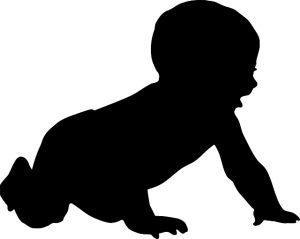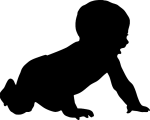by Bernardo R. Sañudo Diez, DC – ICPA.org:
There is nobody in the world as busy as a one-year-old baby, possibly the most productive year of his entire life. So numerous and so different are all his experiences; he goes up and down and touches, smells, feels, and tastes almost everything that comes into his grasp.
His brain needs to put some order to the myriad of experiences he is coming in contact with; it needs to “file” and organize the areas where culture, beliefs, ideas, and knowledge will be stored along all the life of this being.
The baby is too busy: without his knowledge he is growing and his nervous system is maturing. He accomplishes this by performing many activities, including resting to replenish his strength, doing happy but unarticulated movement of his hands, and kicking the air with his little legs.
As time passes, he is able to hold his head and observe the world that surrounds him with a more horizontal and vertical point of view. After accomplishing this task, he will no longer be satisfied by just lying down—he will enrich his world by remaining upright, gaining perspective and depth of spaces and objects.
This tri-dimensional world floods his brain with stimuli that have to be reorganized, learning and re-learning all the time. Consciously he does not know what he is seeing or touching but this miraculous organism will store it and file it anyway. He is so fascinated with all that surrounds him, he is not aware that his spinal column is strengthening. Around six months of age, he is able to sit by himself and gain strength and liberty for his arms, giving him more options in movement and activities to enrich his world.
The joy of playing—throwing and reaching for objects and toys which are farther and farther away from him makes him crave for more and this is how he first discovers “rolling” and then finally, starts to crawl.
Virtually all parents accept that crawling is a milestone all babies must master, but in spite of this, not many realize why it is so important, or how to motivate their babies to accomplish and get the most benefits from this skill. It is very common to hear some parents say that their baby did not crawl or did not want to crawl. In many cases this is because parents do not have time to properly stimulate their babies to develop this skill. Also, because in our busy schedule we need babies to walk in a very short time, we cut them short of a major stage in their physical and neurological development by putting them in a walker or forcing them to walk early.
Crawling not only means a new way of locomotion: as he moves from one side to the other, a lot of very exciting things are happening inside his little head. More and more studies show that crawling has a paramount connection between the physical and neurological development of the baby which, in the future, will be of major importance in his academic and extra-academic performance.
Crawling allows babies to create connections between both cerebral hemispheres. When the baby coordinates his movements to move in one direction, he mostly first moves the right arm and the left leg and then the left arm with the right leg in a reciprocating motion; this is called cross-crawl patterning. Motor nerve impulses to the extremities originate in each side of the brain cortex and cross in the brain stem in an area called the corpus callosum to supply required motor activity to the opposite extremity. This means that when the baby crawls, both hemispheres must communicate and interchange information very fast. What makes this incredible is that these same patterns, or neurological routes, are the same that later in life will be use to perform more difficult tasks, such as walking, running, passing one object from one hand to the other, or even taking notes in a class while listening to the teacher.
The body of the baby must remain in equilibrium and advance in an orderly and organized fashion. The axis that it is formed between the joints of the hips and shoulders should rotate opposite to each other while the baby crawls causing some torsion in the baby’s spine. This torsion will tonify and model the structures of the spinal column, preparing them for an erect posture when the baby starts to walk. The curvatures of the spine, especially the ones at the neck and lower back area, will start to form, setting the basis for the correct spinal model which will accommodate for a proper spinal function and posture. This is very important for the chiropractic doctor because it sets the beginning of a healthy spine.
In addition, when the baby crawls, his body acts against the weight of gravity, developing his vestibular and propioceptive systems. Furthermore, when crawling, the baby touches different surfaces and textures and this will develop the sensibility of his palms and fingers, allowing him in the future to grasp and hold small objects such as a pencil or crayon to draw, write, or play a musical instrument. These two systems will be of utmost importance in his future neurological and cognitive development.
Another area where crawling is very important is the visual aspect of baby’s development. Crawling helps the baby measure the world that surrounds him; the distance between his eyes and his hand when he is in the crawling position will become fundamental in everything he does and will have an impact in his future development. This is called optical convergence, which helps us to know at what distance an object is located, its volume, and its size. It helps the baby to know how the distance from the sofa to the floor and if it is safe to go down face or feet first. This ability will be important in the future in order to clearly see things that are near, such as letters and pictures in a book, or things which are far away, such as words or drawings in the classroom and be able to accommodate far and near objects instantly. Knowing the distance and volume of objects will also help him with puzzles and brain-teasers and will also set the basis for reading and writing skills. So, binocular and stereoscopic vision, convergence, and accommodation will all be developed by crawling, which in due time helps the baby to solve problems, jump obstacles, and understand spatial relationships.
As stated earlier, crawling creates neurological connections which criss-cross between the right and left brain hemispheres; the more the baby crawls the faster these connections will interchange information. This process will transform the brain and produce the phenomenon of lateralization, in which one hemisphere becomes dominant in certain activities and skills. When you throw an object to a baby he will try to catch it with both hands because the information reaches both hemispheres at the same time. But in an older child, he will catch the toy with one hand or the other. His brain will decide which hand is closer or which hand is more skillful to perform the task.
A newborn infant has a crawling instinct right from birth, but babies will usually be ready to crawl between 8 and 10 months. There are different styles of crawling but most of them allow for simultaneously bearing weight on both arms and legs and alternating the movement of opposing extremities. All babies have their own rhythm and time. There is no use to compare the development of infants of the same age, but it is clear that babies without this experience almost always will have some degree of delay in the performance of skills explained before. Crawling is key in developing crucial brain activities and skills that will allow the baby to succeed and to relate to his world in a more complete and satisfying manner. We should stimulate this activity by giving the baby “floor time” every day: placing him belly down to strengthen his neck, arm, and back muscles and placing colorful objects in front of him to encourage forward movements. And always remember to cheer him and to transmit love and confidence.
